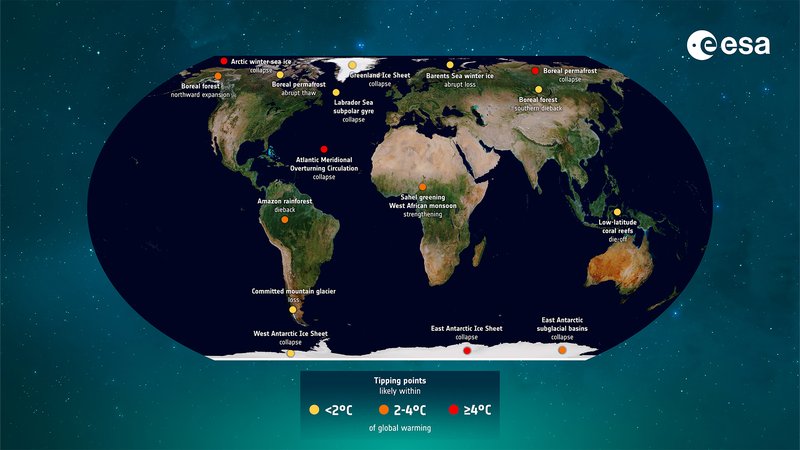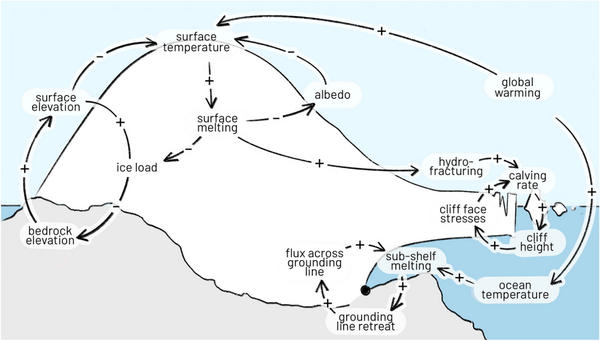As the global temperatures are rising, Earth’s climate system could be pushed towards potentially irreversible changes, triggered at the so-called tipping points. Tipping points are critical thresholds which, once reached, may lead to largescale disruption of ecosystems, changed weather patterns, and an increase of extreme weather events. Scientists are working to better understand them and detect early-warning signals for their onset, using both, models and Earth Observation (EO) data, to try to help society prepare for or ideally avoid these impacts.

Tipping elements include, for example, the melting of ice sheets in Greenland and Antarctica, as well as mountain glaciers. Other examples are the disruption of oceanic circulation or shifts in marine biodiversity, thawing permafrost, and the loss of biodiversity and biomass in tropical and boreal forests. Despite their importance, tipping points remain poorly understood and insufficiently monitored, making them a high-risk blind spot in global climate policy.
Building scientific bridges: Earth observation meets modelling
To address this knowledge gap, scientists are strengthening collaborations across disciplines. The International Space Science Institute (ISSI) has hosted meetings bringing modellers and EO experts together, in partnership with ESA, the World Climate Research Programme and the AIMES project of Future Earth, to shape the research agenda. A recently published Special Issue in Surveys In Geophysics outlines the recommendations made by this community.
In response to these recommendations, ESA has just launched six new projects focused on different tipping elements to improve their risk assessment and support the development of early-warning systems.
One of the most promising developments in the research and monitoring of tipping elements is the integration of satellite remote sensing into climate models. ESA’s new Cryotipping project of the Climate Change Initiative (CCI) will develop new methods to investigate an instability causing the retreat of the Thwaites glacier in Antarctica (see figure 2). Thwaites glacier covers an area of 192, 000 square kilometres, and holds a volume of ice equivalent to a 65-metre rise in sea level, and is thought to be unstable. The team led by Inès Otosaka from Northumbria University in the UK will use EO data to initialise an ice sheet model and investigate the critical slowdown in the rate of its grounding line retreat at the onset of tipping, as well as the potential irreversibility of Thwaites’ retreat over the coming centuries.

While the rapid collapse of Thwaites may appear local, it could destabilise neighbouring glaciers, triggering a much faster and larger contribution to sea level rise that would be global in scale.
From risk awareness to action
The likely interconnectedness of tipping elements across climate systems and ecosystems illustrates the urgent need for deeper understanding enabled by EO data, supported by robust models, and backed by strong international collaboration.
Addressing tipping points forces us to examine the consequences of inaction on greenhouse gas emissions, looking at both plausible and worst-case climate scenarios. “But we can still act in time to avoid many of these global tipping points if we act together and fast,” says Sophie Hebden, ESA Climate Application Scientist. She emphasizes that developing early warning systems is essential for both environmental protection and to inform decision making on climate action for human security.
Satellite data supporting early warning tools
In response to these challenges, the CCI project SIRENE (Satellite Information for Resilience Monitoring and Early warning of Ecosystem tipping points) aims to improve the detection and prediction of climate-driven tipping points in terrestrial ecosystems, such as boreal forests, tropical forests and dryland. The goal is an enhanced understanding of ecosystem resilience and to provide early warning signals to support timely action by policymakers. By integrating Earth Observation, ground-based measurements and machine learning, SIRENE focuses on identifying how stressors like fires, land-use and droughts, affect the ecosystem.
Complementing this, the CCI project PREDICT (Predicting Resilience and Early Detection of Impending Climate Transitions) focuses on biophysical tipping elements, such as Amazon rainforest, dryland vegetation and permafrost. PREDICT aims to advance the scientific understanding of the element’s resilience and vulnerability by combining long-term remote sensing data with statistical methods and process-based modelling, ultimately to support the understanding and development of a biosphere resilience sensing system and predict their potential impacts.
For more information, visit the ESA CCI website on tipping points here. tipping-points-research

